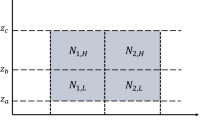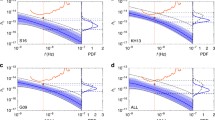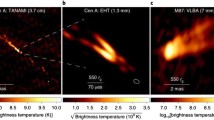Abstract
We briefly discuss a possible cosmological implication of the observed binary black hole mergings detected by LIGO-Virgo-Kagra collaboration (GWTC-3 catalogue) for the primordial black hole (PBH) formation in the early Universe. We show that the bumpy chirp mass distribution of the LVK BH + BH binaries can be fit with two distinct and almost equal populations: (1) astrophysical mergings from BH + BH formed in the modern Universe from evolution of massive binaries and (2) mergings of binary PBHs with initial log-normal mass distribution. We find that the PBH central mass (\({{M}_{c}} \simeq 30{{M}_{ \odot }}\)) and distribution width derived from the observed LVK chirp masses are almost insensitive to the assumed double PBH formation model. To comply with the observed LVK BH + BH merging rate, the CDM PBH mass fraction should be \({{f}_{{{\text{pbh}}}}} \sim {{10}^{{ - 3}}}\) but can be higher if PBH clustering is taken into account.

Similar content being viewed by others
Notes
Chirp-mass in the observer’s frame is determined by measuring signal frequency during the inspiraling along quasi-Keplerian orbits before merging and is degenerate by source redshift \(z\) \({{\mathcal{M}}_{{\det }}} = (1 + z)\mathcal{M}\).
After the mass renormalization \({{M}_{0}} = {{M}_{c}}\exp [{{ - 1} \mathord{\left/ {\vphantom {{ - 1} {(2\gamma )}}} \right. \kern-0em} {(2\gamma )}}]\) the PBH mass distribution can be written as F(m) = \(\sqrt {\frac{\gamma }{\pi }} \frac{1}{m}\exp \left[ { - \gamma {{{\ln }}^{2}}\left( {\frac{m}{{{{M}_{c}}}}} \right)} \right]\) such that \(\int F(m)dm = 1\) (\(\gamma = {1 \mathord{\left/ {\vphantom {1 {2{{\sigma }^{2}}}}} \right. \kern-0em} {2{{\sigma }^{2}}}}\) turns this expression into the standard log-normal form).
REFERENCES
B. P. Abbott et al. (LIGO Scientific Collaboration and Virgo Collaboration Collab.), “Observation of gravitational waves from a binary black hole merger,” Phys. Rev. Lett. 116, 061102 (2016). https://link.aps.org/doi/10.1103/PhysRevLett.116.061102
B. P. Abbott et al. (LIGO Scientific Collaboration and Virgo Collaboration Collab.), “Observation of gravitational waves from a binary neutron star inspiral,” Phys. Rev. Lett. 119, 161101 (2017). https://link.aps.org/doi/10.1103/PhysRevLett.119.161101
B. P. Abbott et al., “Multi-messenger observations of a binary neutron star merger,” Astrophys. J. Lett. 848, L12 (2017). arXiv:1710.05833.
B. D. Metzger, G. Martínez-Pinedo, S. Darbha, E. Quataert, A. Arcones, D. Kasen, R. Thomas, P. Nugent, I. V. Panov, and N. T. Zinner, “Electromagnetic counterparts of compact object mergers powered by the radioactive decay of r-process nuclei,” Mon. Not. R. Astron. Soc. 406, 2650—2662 (2010). arXiv:1001.5029 [astro-ph.HE].
R. Abbott et al. (LVK Collab.), “GWTC-3: Compact binary coalescences observed by Ligo and Virgo during the second part of the third observing run,” (2021). arXiv:2111.03606.
LIGO Scientific Collab., “The population of merging compact binaries inferred using gravitational waves through GWTC-3,” (2021). arXiv:2111.03634.
M. Spera, A. A. Trani, and M. Mencagli, “Compact binary coalescences: Astrophysical processes and lessons learned,” Galaxies 10, 76 (2022). arXiv:2206.15392.
I. Mandel and F. S. Broekgaarden, “Rates of compact object coalescences,” Living Rev. Relativ. 25, 1 (2022). arXiv:2107.14239.
A. V. Tutukov and L. R. Yungelson, “The merger rate of neutron star and black hole binaries,” Mon. Not. R. Astron. Soc. 260, 675—678 (1993).
V. M. Lipunov, K. A. Postnov, and M. E. Prokhorov, “Formation and coalescence of relativistic binary stars: The effect of kick velocity,” Mon. Not. R. Astron. Soc. 288, 245—259 (1997). arXiv:astro-ph/9702060.
L. P. Grishchuk, “Relic gravitational waves and cosmol-ogy,” Phys. Usp. 48, 1235—1247 (2005). arXiv:gr‑qc/0-5-04018.
K. Belczynski, D. E. Holz, T. Bulik, and R. O’Shaughnessy, “The first gravitational-wave source from the isolated evolution of two stars in the 40–100 solar mass range,” Nature 534, 512—515 (2016). arXiv:1602.04531.
C. L. Rodriguez, C. J. Haster, S. Chatterjee, V. Kalogera, and F. A. Rasio, “Dynamical formation of the GW150914 binary black hole,” Astrophys. J. Lett. 824, L8 (2016). arXiv:1604.04254.
C. Kimball, C. Talbot, C. P. L. Berry, M. Zevin, E. Thrane, V. Kalogera, R. Buscicchio, M. Carney, T. Dent, H. Middleton, E. Payne, J. Veitch, and D. Williams, “Evidence for hierarchical black hole mergers in the second LIGO-Virgo gravitational wave catalog,” Astrophys. J. Lett. 915, L35 (2021). arXiv:2011.05332.
H. Tagawa, B. Kocsis, Z. Haiman, I. Bartos, K. Omukai, and J. Samsing, “Mass-gap mergers in active galactic nuclei,” Astrophys J. 908, 194 (2021). arXiv:2012.00011.
B. E. Tetarenko, G. R. Sivakoff, C. O. Heinke, and J. C. Gladstone, “WATCHDOG: A comprehensive all-sky database of galactic black hole X-ray binaries,” Astrophys. J. Suppl. Ser. 222, 15 (2016). arXiv:1512.00778.
S. Bird, I. Cholis, J. B. Muñoz, Y. Ali-Haïmoud, M. Kamionkowski, E. D. Kovetz, A. Raccanelli, and A. G. Riess, “Did LIGO detect dark matter?,” Phys. Rev. Lett. 116, 201301 (2016). arXiv:1603.00464.
S. Blinnikov, A. Dolgov, N. K. Porayko, and K. Postnov, “Solving puzzles of GW150914 by primordial black holes,” J. Cosmol. Astropart. Phys. 11, 036 (2016). arXiv:1611.00541.
M. Sasaki, T. Suyama, T. Tanaka, and S. Yokoyama, “Primordial black hole scenario for the gravitational-wave event GW150914,” Phys. Rev. Lett. 117, 061101 (2016). arXiv:1603.08338.
Ya. B. Zel’dovich and I. D. Novikov, “The hypothesis of cores retarded during expansion and the hot cosmological model,” Sov. Astron. 10, 602 (1967).
B. J. Carr and S. W. Hawking, “Black holes in the early Universe,” Mon. Not. R. Astron. Soc. 168, 399—416 (1974).
V. De Luca, G. Franciolini, P. Pani, and A. Riotto, “The evolution of primordial black holes and their final observable spins,” J. Cosmol. Astropart. Phys. 2020, 052 (2020). arXiv:2003.02778.
B. Carr and F. Kühnel, “Primordial black holes as dark matter: Recent developments,” Annu. Rev. Nucl. Part. Sci. 70, 355—394 (2020). arXiv:2006.02838.
B. Carr, K. Kohri, Y. Sendouda, and J. Yokoyama, “Constraints on primordial black holes,” Rep. Prog. Phys. 84, 116902 (2021). arXiv:2002.12778.
G. Franciolini, I. Musco, P. Pani, and A. Urbano, “From inflation to black hole mergers and back again: Gravitational-wave data-driven constraints on inflationary scenarios with a first-principle model of primordial black holes across the QCD epoch,” Phys. Rev. D 106, 123526 (2022). arXiv:2209.05959.
A. Escrivà, E. Bagui, and S. Clesse, “Simulations of PBH formation at the QCD epoch and comparison with the GWTC-3 catalog,” (2022). arXiv:2209.06196.
A. Dolgov and J. Silk, “Baryon isocurvature fluctuations at small scales and baryonic dark matter,” Phys. Rev. D 47, 4244—4255 (1993).
A. D. Dolgov, M. Kawasaki, and N. Kevlishvili, “Inhomogeneous baryogenesis, cosmic antimatter, and dark matter,” Nucl. Phys. B 807, 229—250 (2009). arXiv:0806.2986 [hep-ph].
B. F. Schutz, “Determining the Hubble constant from gravitational wave observations,” Nature 323, 310–311 (1986).
R. Gamba, M. Breschi, G. Carullo, S. Albanesi, P. Rettegno, S. Bernuzzi, and A. Nagar, “GW190521 as a dynamical capture of two nonspinning black holes,” Nat. Astron. 7, 11—17 (2023). arXiv:2106.05575.
A. D. Dolgov, A. G. Kuranov, N. A. Mitichkin, S. Porey, K. A. Postnov, O. S. Sazhina, and I. V. Simkin, “On mass distribution of coalescing black holes,” J. Cosmol. Astropart. Phys. 2020, 017 (2020). arXiv:2005.00892.
M. Raidal, C. Spethmann, V. Vaskonen, and H. Veermäe, “Formation and evolution of primordial black hole binaries in the early universe,” J. Cosmol. Astropart. Phys. 2019, 018 (2019). arXiv:1812.01930.
L. Liu, Z. Q. You, Y. Wu, and Z. C. Chen, “Constrain the merger history of primordial-black-hole binaries from GWTC-3,” (2022). arXiv:2210.16094.
A. M. Farah, B. Edelman, M. Zevin, M. Fishbach, J. María Ezquiaga, B. Farr, and D. E. Holz, “Things that might go bump in the night: Assessing structure in the binary black hole mass spectrum,” (2023). arXiv:230-1.00834.
S. E. Woosley, “Pulsational pair-instability supernovae,” Astrophys. J. 836, 244 (2017). arXiv:1608.08939.
S. E. Woosley and A. Heger, “The pair-instability mass gap for black holes,” Astrophys. J. Lett. 912, L31 (2021). arXiv:2103.07933.
R. Farmer, M. Renzo, S. E. de Mink, M. Fishbach, and S. Justham, “Constraints from gravitational-wave detections of binary black hole mergers on the 12C(α, γ)16O rate,” Astrophys. J. Lett. 902, L36 (2020). arXiv:2006.06678.
A. Tanikawa, H. Susa, T. Yoshida, A. A. Trani, and T. Kinugawa, “Merger rate density of Population III binary black holes below, above, and in the pair-instability mass gap,” Astrophys. J. 910, 30 (2021). arXiv:2008.-01890.
K. A. Postnov and A. G. Kuranov, “Black hole spins in coalescing binary black holes,” Mon. Not. R. Astron. Soc. 483, 3288—3306 (2019). arXiv:1706.00369.
T. Nakamura, M. Sasaki, T. Tanaka, and K. S. Thorne, “Gravitational waves from coalescing black hole MACH-O binaries,” Astrophys. J. Lett. 487, L139–L142 (1997). arXiv:astro-ph/9708060.
Y. Ali-Haïmoud, E. D. Kovetz, and M. Kamionkowski, “Merger rate of primordial black-hole binaries,” Phys. Rev. D 96, 123523 (2017). arXiv:1709.06576.
K. Ioka, T. Chiba, T. Tanaka, and T. Nakamura, “Black hole binary formation in the expanding universe: Three body problem approximation,” Phys. Rev. D 58, 063003 (1998).
G. Hütsi, M. Raidal, V. Vaskonen, and H. Veermäe, “Two populations of LIGO-Virgo black holes,” J. Cosmol. Astropart. Phys. 2021, 068 (2021). arXiv:2012.02786.
S. G. Rubin, A. S. Sakharov, and M. Yu. Khlopov, “The formation of primary galactic nuclei during phase transitions in the early universe,” J. Exp. Theor. Phys. 92, 921—929 (2001). arXiv:hep-ph/0106187.
Yu. Eroshenko and V. Stasenko, “Gravitational waves from the merger of two primordial black hole clusters,” Symmetry 15, 637 (2023). arXiv:2302.05167.
M. J. Fromerth and J. Rafelski, “Hadronization of the quark universe,” (2002). arXiv:astro-ph/0211346.
ACKNOWLEDGMENTS
We thank A.D. Dolgov for discussions. The authors acknowledge the support from the Russian Science Foundation grant 23-42-00055.
Author information
Authors and Affiliations
Corresponding authors
Ethics declarations
The authors declare that they have no conflicts of interest.
Rights and permissions
About this article
Cite this article
Postnov, K.A., Mitichkin, N.A. On the Primordial Binary Black Hole Mergings in LIGO-Virgo-Kagra Data. Phys. Part. Nuclei 54, 884–888 (2023). https://doi.org/10.1134/S1063779623050192
Received:
Revised:
Accepted:
Published:
Issue Date:
DOI: https://doi.org/10.1134/S1063779623050192




